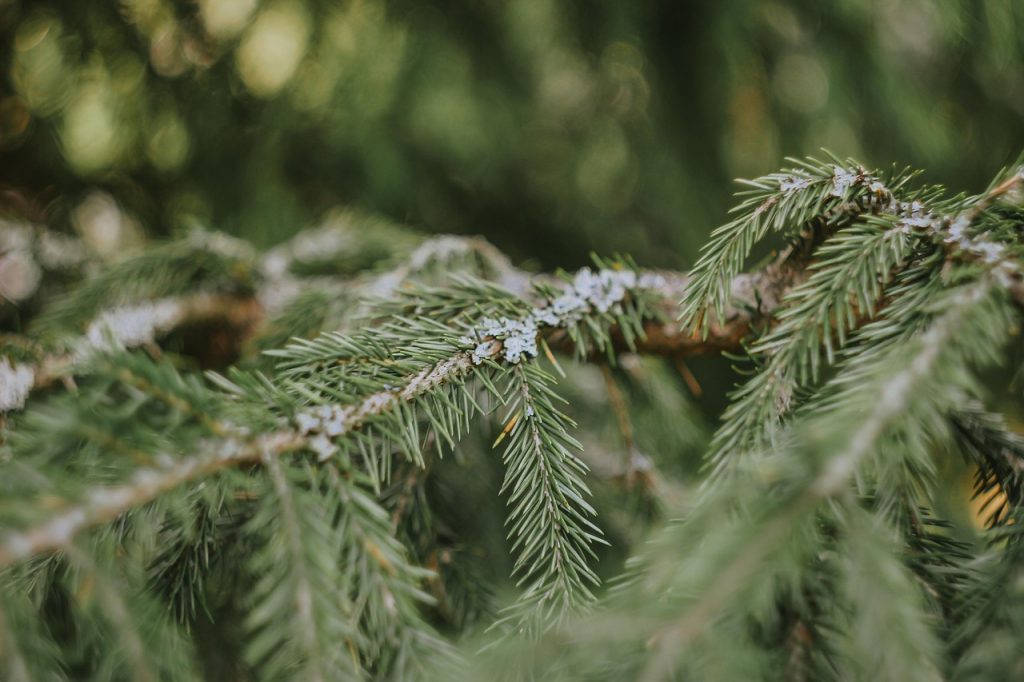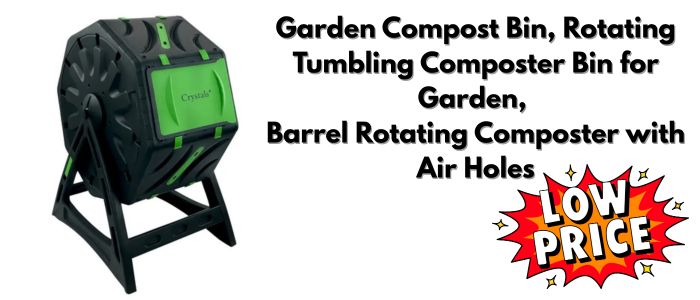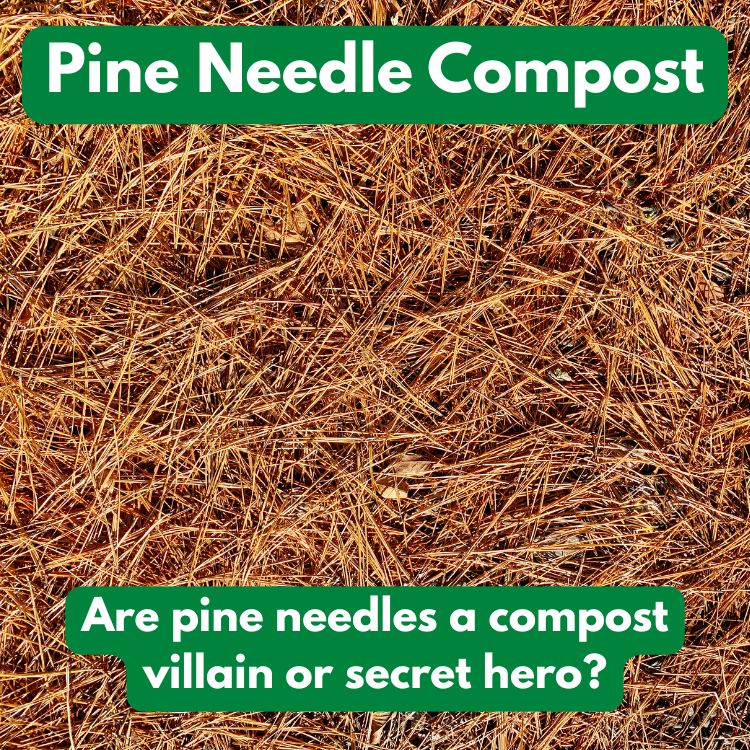Simple Steps for Greener Gardens and Happier Soil
Are pine needles a compost villain or secret hero?
Imagine turning your garden waste and kitchen scraps into rich, dark soil that makes your plants thrive—sounds like magic, right?
That magic is composting! Composting means breaking down organic stuff, like food peels and leaves, to create something useful: compost.
It’s one of the simplest steps for home sustainability, helping you recycle, cut waste, and give your garden a boost.
Pine needle compost stands out, offering a unique twist on classic compost piles. It’s perfect for gardeners who want to put pine needles to good use instead of letting them pile up.
You don’t need a fancy setup, but tools like a compost tumbler or trying vermicomposting (composting with worms) can speed things up and make it fun.
Alongside traditional piles, these methods give you options to fit any lifestyle or space.
If you’re curious about starting, you’ll find simple, clear tips to make pine needle compost work for you.
Composting isn’t just about reducing waste—it’s about growing healthier gardens and living greener every day.
For even more practical guides, explore these 6 Effective Composting Methods at Compost Charm.
Let’s see how easy it can be to get started, even if you’re new to compost or just want to try something different.

Understanding Pine Needle Compost
Pine needle compost is an often-overlooked way to create beautiful, crumbly soil from garden leftovers.
If you live near pine trees or end up with blankets of pine needles in your yard, don’t think of them as a hassle.
They’re a hidden goldmine for your compost pile.
Whether you prefer classic bins, working with a compost tumbler, or experimenting with worms through vermicomposting, pine needle composting can help you boost soil health while keeping your garden tidy.
What Is Composting and Why Compost Matters?
Composting is nature’s way of recycling. It’s the process of taking everyday organic scraps—like coffee grounds, veggie peels, and leaves—and letting microbes transform them into a dark, earthy material called compost.
When you compost, you’re not just managing waste; you’re actively building healthier soil for your flowers and veggies.
 Photo by Irina Iriser
Photo by Irina Iriser
Why does this matter? Here are three big reasons:
- Reduces landfill waste: When food and yard scraps break down in landfills, they don’t compost—they rot and make harmful methane gas.
- Feeds your garden naturally: Finished compost adds life, nutrients, and structure to your soil.
- Supports a greener home: Composting means less curbside waste and fewer chemical fertilizers.
Not sure where to begin?
Starting small is often the best step, so find more straightforward ideas in the guide to starting composting at home, or get a fresh perspective from Composting 101.
How Pine Needles Fit Into Composting
Pine needles are considered a “brown” in composting. This means they’re rich in carbon, which helps balance out “greens” like veggie scraps or lawn clippings (that are loaded with nitrogen).
The right mix of greens and browns is essential for a healthy compost system.
Some gardeners worry that using pine needles will make their compost too acidic. Good news—this is mostly a myth.
While fresh pine needles do have a low pH, they lose much of their acidity as they break down.
When mixed with other compost ingredients, pine needles won’t turn your pile overly acidic or hurt your plants.
Here’s why pine needles deserve a spot in your bin:
- Great for layering: Their airy shape keeps compost fluffy, encouraging needed airflow.
- Slow to break down: They won’t vanish overnight, making them ideal for steady composters and mulching between batches.
- Easily available: If you have pine trees, you’ve got a free, renewable resource!
To learn handy hints on balancing compost piles and managing materials like pine needles, visit Composting Pine Needles.
The Science Behind Pine Needle Decomposition
Pine needles don’t break down as quickly as other yard waste. Their tough, waxy coating repels water and protects them from hungry microbes and worms.
Think of pine needles as the “slow cookers” in your compost recipe—they take their time.
For a thriving pile, you need both fast-decaying “greens” and longer-lasting “browns” like pine needles.
Pairing pine needles with moist greens (kitchen peels, lawn clippings, or even coffee grounds) speeds up the process, especially when you toss everything in a compost tumbler or use vermicomposting to introduce worms that love soft material.
Why does this combination work?
- Greens provide quick energy for microbes.
- Browns (like pine needles) add staying power and keep the pile from turning into mush.
- Good airflow, moisture, and a temperature boost help overcome the needles’ waxy outer layer.
For those interested in the nitty-gritty science, studies show pine needles can take several years to fully decompose, but they still play a key role in carbon cycling and soil enrichment.
If patience is part of your gardening approach, pine needle compost pays off. Want more practical tips on methods and timing?
Explore these clever Composting Calendar Tips or review a detailed 5-year pine needle decomposition study.
With pine needle compost, you can keep your soil and your conscience cleaner, using what nature sends your way—one crunchy, fragrant needle at a time.
How to Compost Pine Needles Successfully
Composting pine needles adds a unique boost to your garden’s soil, but they do take a bit of extra know-how.
While pine needle composting is easy, it helps to follow a few smart steps so your pile breaks down quickly and doesn’t turn stubborn or sour.
Here’s how to jump in and turn those prickly needles into garden gold.
Getting Started: Gathering and Preparing Pine Needles
 Photo by Pixabay
Photo by Pixabay
The secret to a healthy pine needle compost pile starts right at the gathering stage. Always use dry, brown pine needles instead of fresh, green ones.
Dried needles are already starting to decompose and won’t throw off your compost’s balance. Green needles break down slowly and can make your pile too acidic.
Breaking up the pine needles is your ticket to faster composting. Here’s how you can do it at home:
- Shred or chop needles: Run over them with a lawn mower, use garden shears, or even crush handfuls by hand. The smaller the pieces, the easier they are for microbes and worms to eat.
- Remove big sticks or cones: Toss only loose needles or smaller twigs to keep your pile tidy.
When building your pile, layer pine needles with moist greens and other browns, much like lasagna.
Try alternating a few inches of shredded needles with kitchen peels or grass clippings for an even breakdown.
Need a deep dive on prepping pine needles? The guide at Composting Pine Needles shows how even small changes can speed things up.
Mixing Pine Needles with Other Compost Materials
Think of pine needles as the “crunchies” in your compost salad. They’re great, but you don’t want them to take over the whole bowl!
To make the ideal pine needle compost, balance your browns and greens carefully.
- Browns: These include pine needles, dry leaves, and cardboard. They provide carbon.
- Greens: Kitchen scraps, coffee grounds, and grass clippings. They give your pile much-needed nitrogen.
Try keeping your pine needles to about 10% of the total compost mix. Blend them with more nitrogen-rich “greens” for a speedy, less acidic compost.
Need help with ratios? Use the classic compost formula:
- Add one part pine needles (browns)
- Add two parts kitchen waste or lawn clippings (greens)
- Mix well
A compost tumbler can keep everything mixed and aerated with nearly no work. Rotating the bin every few days keeps oxygen flowing and prevents the pile from getting soggy or smelly.
For step-by-step help, see the full instructions on how to use a compost tumbler.
If you compost a lot and want new approaches, check out these 6 Effective Composting Methods to fit every space and style.

Tips and Tricks for Faster Pine Needle Composting
Pine needles can be slowpokes in the compost pile because of their waxy coating.
The good news? There are easy ways to speed things up:
- Turn your pile often: Grab a garden fork or turner to mix everything every week or two. This gives microbes the air they need and keeps things moving.
- Check moisture levels: Compost should feel like a wrung-out sponge. If your pile is dry, sprinkle it with water. If too wet, add more dry browns—like shredded pine needles!
- Shred needles before adding: Finer pieces break down quicker, so give those needles a good whack or mow.
Want to go even faster? Compost tumblers are perfect for regular turning and easy mixing.

If you like the idea of composting with worms, a vermicomposting bin lets red wigglers chew through soft foods while tougher pine needles break down over time.
Trouble signs and fixes:
- Is your pile breaking down too slowly? Chop needles smaller, add more green material, and turn the pile more often.
- Worried about acidity? Mix pine needles with other compost materials and avoid overloading; they lose acidity as they compost. For proof, see the guide on making pH-neutral pine needle compost.
- Pile looks dry or doesn’t shrink down? Check water levels or add moist green scraps.
Mix, chop, and balance—soon your pine needle compost will be ready to spread on garden beds or lawn. Want more seasonal tricks to maximize your efforts?
The Composting Calendar Tips have you covered for every time of year.
For even more detailed tips, you’ll find a practical list of do’s and don’ts in this nutrient-rich composting guide.
With the right prep, mix-ins, and a bit of turning, pine needle compost becomes a slow-release treat for your garden—gentle, steady, and rich. Happy composting!
Creative Uses and Benefits of Pine Needle Compost
Don’t let pine needles stay sidelined in your yard—they deserve a starring role in your compost adventures! Pine needle compost isn’t just an eco-friendly way to tidy up under your trees.
It brings real value to your soil, plants, and even your garden pathways.
There’s a world of clever uses waiting for the fragrant bounty you scoop up each season.
How Pine Needle Compost Boosts Your Garden
 Photo by Dino
Photo by Dino
Pine needle compost might look rustic, but it works hard beneath your plants.
When you add it to your soil, you’re not just tossing around leaf litter; you’re helping your garden get stronger, bit by bit.
Here’s what makes pine needle compost so good for your garden:
- Improves soil structure: The fine, airy texture of composted pine needles helps soil stay loose. That means roots can spread easily and water soaks in better instead of puddling or running off.
- Enriches with nutrients: As pine needles break down, they give back nitrogen, potassium, and a dash of organic matter. Your plants love the gentle, steady boost—think of it as a slow-release vitamin.
- Encourages healthy microbes: The compost acts as a buffet for friendly soil organisms. More worms and good bacteria means healthier roots and more robust veggies or flowers.
- Reduces weed growth: A layer of pine needle compost can make it tougher for weeds to sprout, which saves you weeding time.
People sometimes worry about leftover acidity from pine needles. Here’s the honest scoop: by the time pine needles finish composting, they’re about as neutral as regular leaf compost.
The myth that pine needle compost will sour your soil just doesn’t hold up. That’s confirmed by experts—see for yourself in this helpful piece about pine needles and soil acidity.
Whether you compost in a pile, compost tumbler, or opt for vermicomposting, pine needles blend right in and work their slow magic alongside your other garden waste.
Other Fun Ways to Use Pine Needle Compost
Why save pine needle compost just for your garden beds?
Its unique texture and smell open the door to lots of other creative, earth-friendly uses around your home.
Here are some simple, smart ideas for using pine needle compost:
- Garden Pathways: Lay down a layer of pine needle compost along walkways. It keeps mud at bay, controls weeds, and creates a soft base underfoot.
- Mix Into Potting Soil: Boost your potted plants! Add a scoop or two to your DIY potting mix for extra fluff and nutrients.
- Mulch for Trees and Shrubs: Spread around the base of shrubs and trees. It helps lock in soil moisture and adds slow-release nutrients right where roots need them.
- Lawn Top-Dressing: Sprinkle lightly over patchy lawn spots to improve soil and seed contact.
Love do-it-yourself garden projects or want a crafty way to compost more pine needles? Check out the step-by-step DIY Trash Can Composter Guide for a simple, budget-friendly build.
It’s a clever way to start composting right where you need it, and a perfect fit for experimenting with pine needles.
If you’re curious to learn even more about turning pine needles (and other garden waste) into rich, crumbly compost, dig into the practical tips and tricks for nutrient-rich composting that simplify the process for everyone.
Trying new approaches, like tossing pine needle compost on walkways or in potted plants, makes your efforts stretch further and helps your garden shine.
For even more seasonal advice and innovative composting ideas, check out these Composting Calendar Tips to keep your compost pile thriving all year.
Pine needle compost can be so much more than just a soil booster—it’s your new favorite garden multitasker!
Summary and FAQs on Pine Needle Compost
Pine needle compost is a clever way to recycle what nature provides and boost your garden’s health. It makes use of something often overlooked—those piles of pine needles under your trees.
Composting pine needles does require patience because they break down slower than kitchen scraps or soft yard waste, but with a good mix and a little turning, they bring lasting benefits to your soil.
You can add them to compost bins, try a compost tumbler for speed, or even blend them into vermicomposting setups.
If you want to make the most of your pine needles, understanding the basics and having answers to common questions can save you time and effort.
That’s exactly what you’ll find in this section.
Quick Recap: Key Points About Pine Needle Compost
- Pine needles are a carbon-rich “brown” and help keep your compost airy.
- Best when shredded and mixed with lots of moist “greens” like veggie peels.
- They decompose slowly but make nutrient-rich, gentle compost perfect for many garden uses.
- Acidity worries are mostly a myth: Finished pine needle compost is usually close to neutral and safe for most plants.
- Tools like a compost tumbler or regular turning help speed up the process.
- Great for mulching, top-dressing lawns, and pathways—not just for garden beds.
Curious about balancing your pile or speeding things up? The 6 Effective Composting Methods provide handy tricks for all styles, from backyard bins to tumbler setups.
Frequently Asked Questions About Pine Needle Compost
Below are some common questions about composting with pine needles, answered simply for easy reading.
Can I compost pine needles with other materials?
Yes! Pine needles pair well with kitchen scraps, leaves, coffee grounds, and even paper. Mix them with nitrogen-rich “greens” to get a speedy, healthy compost pile.
For a walk-through on the balance of browns and greens, see this guide to composting pine needles.
Will pine needles make my compost too acidic?
No need to worry. While fresh pine needles are acidic, they lose most of their acidity as they break down.
Finished pine needle compost is usually pH-neutral and safe for vegetables, flowers, or lawns.
How long does it take for pine needles to compost?
Generally, pine needles take longer than most leaves—often up to 2 years if left whole. You can shred them with a mower to speed this up. Mixing and aerating your pile (or using a compost tumbler) also helps.
Can I use pine needle compost around all plants?
Yes! By the time pine needles are finished composting, they’re perfect for most plants. Spread them on garden beds, around trees, or even as lawn top-dressing.
If you want a step-by-step composting guide for different areas of your home, check out How to Start Composting at Home.
What’s the best way to shred pine needles before composting?
A simple way is to run them over with a lawn mower or chop them up with shears. Smaller pieces mean faster breakdown and more even compost.
Should I try a compost tumbler or vermicomposting with pine needles?
Absolutely! Compost tumblers make it easy to turn your pile and help mix slow materials like pine needles with softer stuff.
Vermicomposting works better for kitchen scraps, but any leftover pine needle-rich compost can be mixed in once it’s broken down a bit.
Where can I get more tips for composting pine needles?
For deeper tips, see the practical advice and troubleshooting from real composters at Composting Pine Needles (Tips and Tricks for Nutrient-Rich Compost). This guide covers everything from shredding to pile balance.
Pine needle composting doesn’t have to be complicated.
With these clear answers and helpful guides, you’re set to tackle your next compost project with confidence. Happy composting!
Conclusion
Pine needle compost is a fantastic way to boost your garden’s health while cutting down on waste.
With a little patience and the right mix, even those piles of prickly pine needles can become gentle, nutrient-rich compost for your beds, pots, and pathways.
Composting, whether with a classic pile, a handy compost tumbler, or vermicomposting, doesn’t need to be complicated—small steps add up to big results for both your soil and the planet.
Ready to recycle more and grow greener?
Try adding pine needle compost to your gardening routine and notice how your plants thrive.
If you want even more tips and encouragement, browse through resources like the kitchen waste composting guide for more ideas on making the most of what you already have.
Take the next step to live more sustainably and join others on the same journey by exploring creative composting tips from the Don’t Toss It Campaign.
Thank you for being part of a growing movement that turns garden waste into something wonderful. Have you started your composting adventure yet?
If so, share your progress—your story may inspire someone else.





